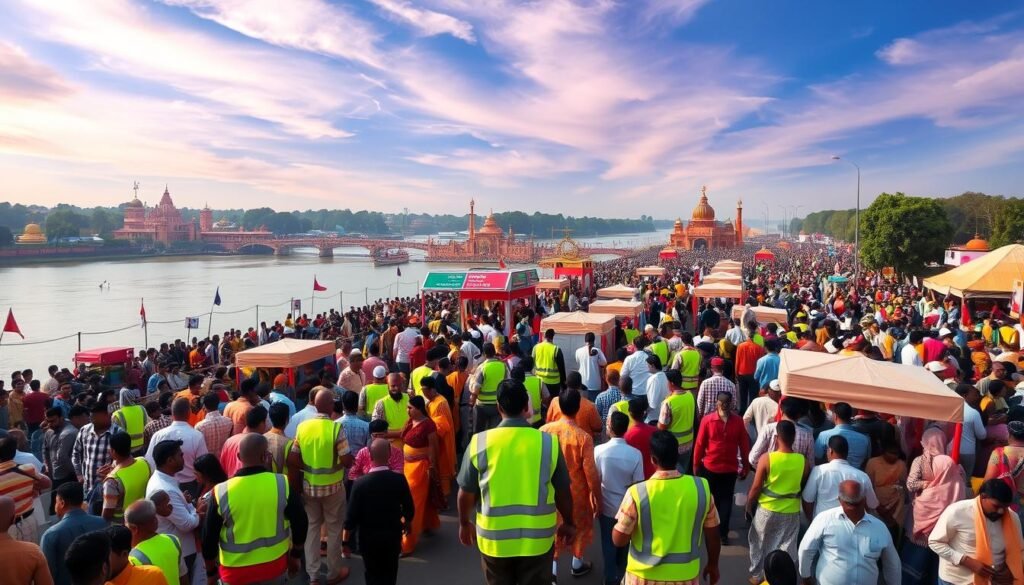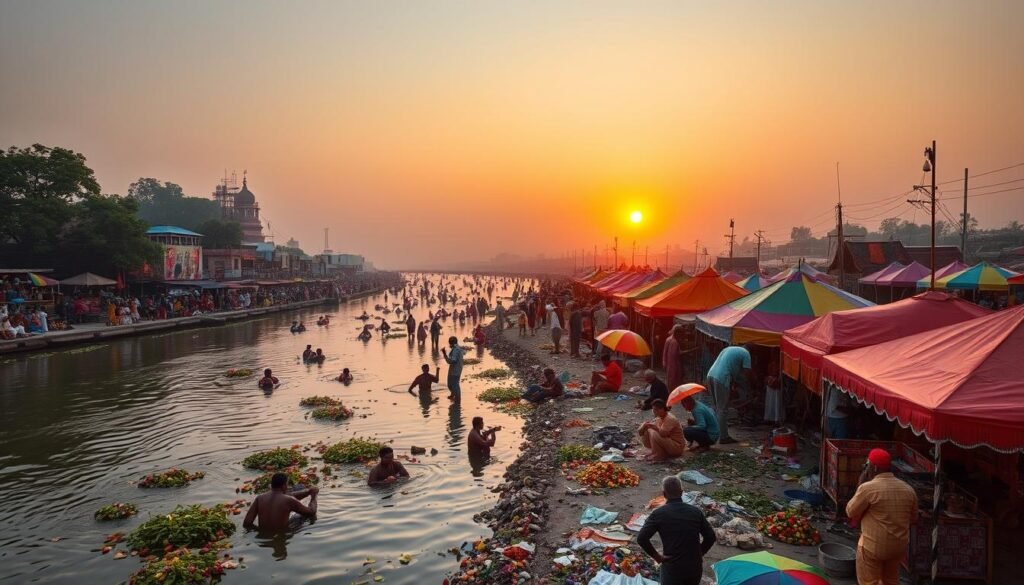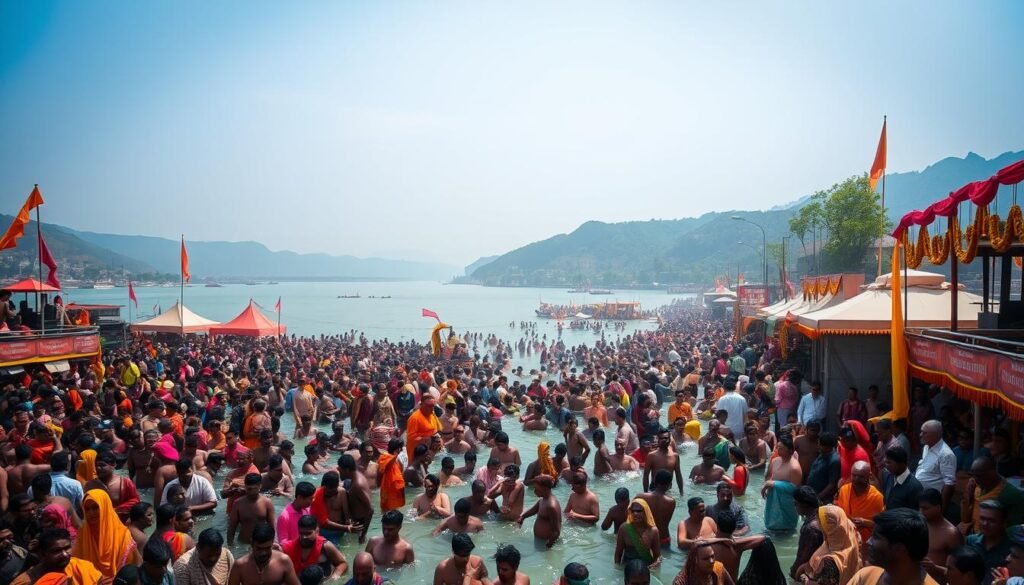Kumbh Mela happens every 12 years. The last one was the biggest peaceful gathering ever on 4 February 2019. It takes place at four riverside sites: Prayagraj, Haridwar, Nashik, and Ujjain. It shows India’s unity and rich culture.
The Kumbh Mela’s history goes back thousands of years. It started in the Maurya and Gupta periods. Many royal dynasties supported it, like the Chola, Vijayanagar, Delhi Sultanate, and Mughal empires. It’s a key part of India’s culture. Knowing its history helps us understand the Maha Kumbh 2025’s importance.
Key Takeaways
- The Kumbh Mela is celebrated in a cycle of approximately 12 years.
- The festival is mainly held at four riverside pilgrimage sites: Prayagraj, Haridwar, Nashik, and Ujjain.
- The History of Kumbh Mela dates back thousands of years, with roots in the Maurya and Gupta periods.
- The Maha Kumbh 2025 is expected to be one of the largest gatherings in the festival’s history.
- The Kumbh Mela symbolizes national unity and India’s rich cultural heritage.
- UNESCO recognized the Kumbh Mela as an intangible cultural heritage of humanity in 2017.
Understanding the Kumbh Mela Tradition
The Kumbh Mela is a big event in Hindu culture. It has a rich history and myths around it. The History of Kumbh Mela comes from the Puranas, telling the story of gods and demons fighting over amrita. This myth has led to many Kumbh Mela myths and facts that people debate today.
The Kumbh Mela is all about celebrating the sacred and divine. It’s a time for spiritual reflection, renewal, and connecting with the divine. The festival shows the power of faith and the human spirit, drawing millions of devotees worldwide.
Origins of the Kumbh Mela
The Kumbh Mela’s origins are full of myths and legends. It started when gods and demons fought over amrita, which granted immortality. Now, it’s a celebration of the sacred, with many rituals and practices that are key to the Kumbh Mela tradition.
Significance of the Festivals
The Kumbh Mela is important for its spiritual and cultural value. It also has big economic and social impacts. The festival brings in a lot of money for local economies. It also helps people from different backgrounds come together, promoting unity and understanding.
The Role of Pilgrimage in Hindu Culture
Pilgrimage is very important in Hindu culture, with the Kumbh Mela being a major pilgrimage. The festival shows the strength of faith and the human spirit. It draws millions of devotees seeking spiritual enlightenment and connection with the divine.
Some key facts about the Kumbh Mela include:
- The festival is celebrated every 12 years at four sacred sites in India: Prayagraj, Haridwar, Ujjain, and Nashik.
- The Kumbh Mela is expected to draw over 400 million devotees in 2025.
- The festival has been recognized by UNESCO as an Intangible Cultural Heritage of Humanity.
Major Locations for Maha Kumbh 2025
The Maha Kumbh 2025 will take place at four key spots in India. Each spot has its own special features and spiritual importance. These places are sacred because they are linked to holy rivers.
The locations are Haridwar, Allahabad, Nashik, and Ujjain. Each place has unique attractions, making them essential for those attending the Maha Kumbh 2025.
Haridwar: A Sacred River
Haridwar is a key spot for the Maha Kumbh 2025. It’s on the Ganges River and is known for its beauty and spiritual value.
Allahabad: The Confluence of Rivers
Allahabad, or Prayagraj, is another major site for the Maha Kumbh 2025. It’s where the Ganges, Yamuna, and Saraswati rivers meet, making it sacred for pilgrims.
Nashik: A Spiritual Destination
Nashik is a spiritual hub that draws millions during the Maha Kumbh 2025. It’s on the Godavari River and is famous for its temples and spiritual importance.
Ujjain: The City of Temples
Ujjain is known as the city of temples and is a key location for the Maha Kumbh 2025. It’s on the Shipra River and is famous for its temples and spiritual value.
The Maha Kumbh 2025 will draw millions from around the world. It’s a celebration of the History of Kumbh Mela and is a must-see for those interested in spirituality and culture.
| Location | River | Significance |
|---|---|---|
| Haridwar | Ganges | Sacred river and stunning natural beauty |
| Allahabad | Ganges, Yamuna, Saraswati | Confluence of rivers and spiritual significance |
| Nashik | Godavari | Spiritual destination and stunning temples |
| Ujjain | Shipra | City of temples and spiritual significance |
The Rituals and Practices of Kumbh Mela
The Kumbh Mela is a celebration of community, marked by a ritual dip in the holy waters. This festival is filled with tradition and mythology. Many myths and facts surround its origins and significance. As the Maha Kumbh 2025 approaches, millions of pilgrims will gather at the banks of the Ganges, Yamuna, and Sarasvati rivers.
They will participate in various rituals and practices.
Some of the key practices include:
- Bathing in the holy waters, believed to cleanse sins and bring spiritual purification
- Spiritual discourses and gatherings, featuring leaders and gurus from various religious orders
- Cultural performances and exhibitions, showing India’s rich heritage and diversity
The Kumbh Mela is a unique chance for spiritual seekers to gather. They can discuss philosophy and share wisdom. With its rich history and cultural significance, the Maha Kumbh 2025 is expected to be unforgettable. It will attract millions of pilgrims and visitors from around the world.
The Size and Scale of Kumbh Mela
The History of Kumbh Mela shows its massive scale. It draws millions of pilgrims from all over. The Maha Kumbh 2025 is set to be the biggest, with over 40 crore pilgrims expected.
The festival’s economic impact is huge. The 2025 Maha Kumbh is expected to generate around ₹2 lakh crore in economic activity. This is a big jump from the 2019 Kumbh, which had an impact of ₹1.2 lakh crore.
| Year | Attendance | Economic Impact |
|---|---|---|
| 2019 | 25 crore | ₹1.2 lakh crore |
| 2025 | 40 crore | ₹2 lakh crore |
Extensive infrastructure developments are underway to handle the pilgrims. The Uttar Pradesh state government is investing around Rs 6,990 crore for the 2025 Kumbh. This will boost the local economy, creating jobs and driving growth.

The Evolution of Maha Kumbh Over the Years
The History of Kumbh Mela is rich and fascinating, spanning thousands of years. The festival has changed a lot but kept its spiritual heart. The Indian government introduced a bathing order to avoid fights between groups.
Some Kumbh Mela myths and facts are quite interesting. For example, it draws millions of pilgrims, making it the world’s largest peaceful gathering. The area in Prayagraj has been made a separate district for better facilities. The festival now uses technology, like digital lost and found centers and social media, to connect people.
| Category | Details |
|---|---|
| Expected Attendance | 40 crore devotees |
| Accommodation Capacity | Up to 100 crore people |
| Transportation Arrangements | Over 13,000 trains and 250 flights |
Looking ahead, the History of Kumbh Mela will keep evolving. It will use new technologies while keeping its spiritual essence. By learning about Kumbh Mela myths and facts, we can see its lasting spirit and how it brings people together.
Safety and Security Measures at Kumbh Mela
The Maha Kumbh 2025 is set to attract a huge crowd. It’s estimated that 40 to 50 crore people will visit Prayagraj and other religious sites over 45 days. To keep everyone safe, the authorities have put in place advanced security steps. This includes a seven-level security system and around 50,000 police officers.
Some of the key safety and security measures include:
- 2,700 CCTV cameras, including AI-enabled ones, to monitor crowd density and any security issues
- 10 digital lost and found centres to help pilgrims find their lost items
- Three Mahila police stations and 10 pink booths to improve women’s safety
These steps aim to tackle common Kumbh Mela myths and facts. They ensure a safe and enjoyable space for pilgrims. The authorities are also working with school and college students. They aim to spread the word about safety and fight false information.

The event will have six key dates, including three “Shahi Snan” (royal bath) days. The authorities are making sure pilgrims have a safe and fun time. By knowing the Kumbh Mela myths and facts, pilgrims can appreciate the safety efforts made for Maha Kumbh 2025.
| Security Measure | Description |
|---|---|
| CCTV Cameras | 2,700 cameras, including AI-enabled ones, to monitor crowd density and any security issues |
| Digital Lost and Found Centres | 10 centres to help pilgrims find their lost items |
| Mahila Police Stations | Three stations to enhance women’s safety |
Prominent Leaders and Spiritual Figures
The History of Kumbh Mela is deeply connected with spiritual leaders and figures. These leaders have greatly influenced the festival, drawing millions of devotees. As Maha Kumbh 2025 nears, their presence will make the event even more spiritual.
Sadhus, gurus, and hermits from different Hindu traditions will come together. They will share their wisdom with pilgrims. The festival is a chance for spiritual growth and renewal, with many seeking guidance from these leaders.
Influential Gurus and Saints
Renowned spiritual leaders from Ayodhya and India will attend Maha Kumbh 2025. They have spent their lives helping others grow spiritually. Their teachings and talks will be a big part of the festival, drawing many devotees.
Notable Organizations and Their Involvement
Many organizations, like cultural and religious groups, will join Maha Kumbh 2025. They will help with the festival’s activities, such as exhibitions and performances. Their involvement will make the festival richer and more diverse.
The History of Kumbh Mela and Maha Kumbh 2025 are linked to these leaders and organizations. As the festival grows, their role will remain key to its success and importance.
Environmental Considerations
Millions of pilgrims are coming to the Kumbh Mela, raising big environmental worries. The festival’s waste is huge, with daily waste around 827 MT. A lot of this waste can’t be broken down easily.
The sector-wise waste generation is a big problem. Hospital, commercial, and total waste are major contributors. With more people coming in 2025, the waste is expected to hit 1102.57 MT daily.
To tackle these issues, Maha Kumbh 2025 is using green materials and energy-saving tech. They’re also keeping the sacred rivers clean with new waste management and clean-up plans.
It’s key to know the real environmental effects of the Kumbh Mela. While there are hurdles, the efforts to protect the environment are moving forward. The plans for Maha Kumbh 2025 are a positive step.

| Year | Number of Visitors | Waste Generation (MT) |
|---|---|---|
| 2019 | 150 million | 827 |
| 2025 (forecasted) | 176,302,000 | 1102.57 |
The Role of Media in Kumbh Mela
The History of Kumbh Mela is filled with stories from many media sources. As we get closer to Maha Kumbh 2025, media’s role in showing the festival to the world is bigger than before.
Media coverage of Kumbh Mela has changed a lot. It now includes social media, not just traditional news. This change has made the festival known to more people. It has also changed how people attend and experience the festival.
Some important parts of media coverage in Maha Kumbh 2025 are:
- News outlets sharing the festival’s cultural and spiritual importance
- Social media’s impact on attendance, with many sharing their experiences online
- Digital platforms providing info and services to pilgrims, like the Maha Kumbh 2025 app and website
Looking ahead, media will keep being key in telling the story of Kumbh Mela. The festival’s recognition by UNESCO shows its global importance. As we approach Maha Kumbh 2025, it will be interesting to see how media coverage helps the festival grow.
Kumbh Mela: A Global Perspective
The Kumbh Mela is a huge event that brings together millions from all over. It’s the biggest spiritual gathering in the world. In 2025, it will be held in Prayagraj, India, showing devotion, unity, and spiritual heritage.
It’s a time when people come together to celebrate their faith. The Maha Kumbh Mela 2025 will be the largest gathering of humans on Earth.
Some of the key aspects of the Kumbh Mela include:
- Deep-rooted practices of Dev Pujan, Shraadh, Veeni Daan, and Satsang
- Acts of giving, such as Gau Daan, Vastra Daan, Dravya Daan, and Swarn Daan
- The ritual of Deep Daan, where devotees float thousands of lighted earthen lamps on the Triveni Sangam
It’s important to know the Kumbh Mela myths and facts. The preparations for Maha Kumbh 2025 are already underway. It aims to give a special experience to international visitors.
The event will run from January 13 to February 26. Dates like Paush Purnima and Makar Sankranti are very important.

Future Prospects for Kumbh Mela
The Maha Kumbh 2025 is set to be a major event. The Indian Railways is spending Rs 450 crore to improve train services. They plan to run 13,000 trains, including 3,000 special ones for the festival. The History of Kumbh Mela shows the festival is getting bigger, and 2025 is expected to draw many pilgrims.
Some key features of the Maha Kumbh 2025 include:
- 350 shuttle buses will be available in Prayagraj, with the number increasing to 7,000 on key bathing dates.
- 300 app-based e-rickshaws will be introduced in Prayagraj.
- A “Pink Taxi” service operated by women drivers will be launched for the 2025 Maha Kumbh Mela.
The Maha Kumbh 2025 is expected to welcome nearly 40 crore pilgrims. This is a big jump from 25 crore in 2019. The event aims to break four world records, including the largest synchronized sweeping drive and the biggest river-cleaning drive. With its rich History of Kumbh Mela, the festival is expected to keep growing, while staying true to its spiritual and cultural roots.
Conclusion: The Enduring Spirit of Kumbh Mela
As we wrap up our look at the history and evolution of Kumbh Mela, it’s clear this festival holds a special spot in many hearts. It’s more than a religious event; it shows the lasting power of tradition and spiritual unity.
In today’s fast-paced world, Kumbh Mela reminds us of the value of our cultural heritage and myths. It brings millions together, crossing all boundaries. This shared experience of faith is truly inspiring.
The festival offers a chance for personal growth and joy through its sacred rituals, spiritual talks, and cultural shows. As we look forward to Maha Kumbh 2025 in Prayagraj, we expect an even bigger celebration. It will continue to inspire and connect people, showing the power of human connection and spiritual exploration.
FAQ
What is the historical significance of the Kumbh Mela festival?
The Kumbh Mela is an ancient Hindu festival. It has been celebrated for centuries. It holds deep spiritual significance in Hindu culture, coming from the myth of the churning of the milk ocean.
How does the Kumbh Mela festival embody the importance of pilgrimage in Hinduism?
Kumbh Mela is a key part of Hindu pilgrimage tradition. It draws millions of devotees worldwide. They come to bathe in sacred rivers and practice spirituality.
What are the four main locations where the Kumbh Mela is celebrated?
The Kumbh Mela is held in four main places. These are Haridwar, Allahabad (also known as Prayagraj), Nashik, and Ujjain. Each place has its own historical and spiritual importance.
What are the key rituals and practices that take place during the Kumbh Mela?
The Kumbh Mela features many spiritual activities. These include bathing in holy rivers and listening to religious leaders. There are also cultural performances that show India’s rich heritage.
What is the scale and logistical challenge of hosting the Kumbh Mela?
The Kumbh Mela is the world’s largest religious gathering. It attracts millions of pilgrims. Hosting it requires a lot of infrastructure and planning to manage crowds and provide services.
How has the Kumbh Mela evolved over the years?
The Kumbh Mela has kept its spiritual core but has also changed. It now uses modern technology and meets the needs of more pilgrims.
What safety and security measures are in place during the Kumbh Mela?
The festival uses advanced crowd management and health measures. There are also safety protocols to protect the millions of pilgrims.
What is the role of prominent spiritual leaders and organizations in the Kumbh Mela?
The Kumbh Mela welcomes many influential gurus and organizations. Their teachings and presence make the festival a place for spiritual growth and renewal.
How does the Kumbh Mela address environmental concerns?
The festival organizers focus on keeping the sacred rivers clean. They also try to be sustainable, despite the challenges of hosting millions of pilgrims.
How has media coverage shaped the perception of the Kumbh Mela?
Media has greatly influenced how people see the Kumbh Mela. From early writings to today’s digital coverage, it has shaped our understanding of the festival.
What is the international perspective on the Kumbh Mela?
The Kumbh Mela is recognized worldwide. It attracts visitors from different cultures and religions. They share in cultural exchange and learn about the festival.
What are the future prospects for the Kumbh Mela, particularlly the upcoming Maha Kumbh 2025?
The Kumbh Mela is expected to continue to evolve. It will adapt to new technologies and address future challenges. It will remain a significant spiritual and cultural event for devotees worldwide.
Shuchi Pandey is a distinguished author and scholar with a profound expertise in Hinduism with a leading voice in the study and interpretation of Hindu philosophy, rituals, and cultural traditions. She aims to bridge the gap between academic rigor and engaging storytelling by exploring the depths of Hindu thought, from the ancient Vedas to contemporary practices.




